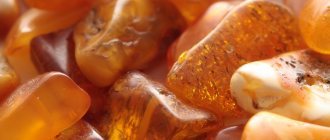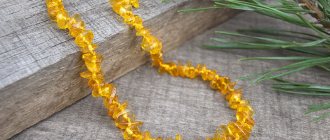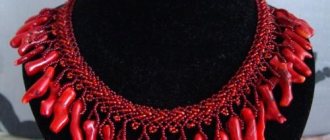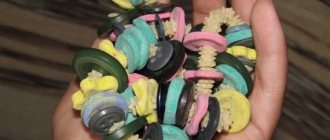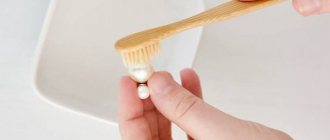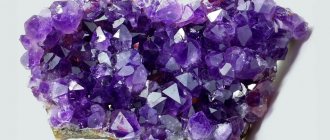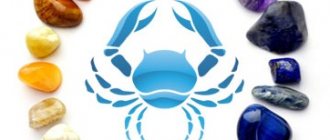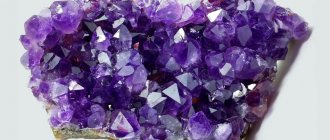One of the most effective therapeutic agents for hypothyroidism is amber beads. They will help not only with the treatment of the thyroid gland, but also with pathological processes in the female reproductive system. Read on to learn how to use them and why amber is useful.
DOES AMBER HELP WITH THYROID DISEASES?
There is an opinion that amber is effective in the treatment of thyroid disease as an addition to the course of treatment.
- The composition of the sun stone includes elements that affect the endocrine system.
- The main substance that benefits the body is succinic acid.
- When the stone shell rubs against the skin, an electromagnetic field is generated. Active substances penetrate the circulatory system through skin cells and are distributed throughout the body.
- Most succinic acid is found in dark-colored stones. There is also a lot of iodine present here, which is needed for the normal functioning of the endocrine system.
- Phytoncides help restore thyroid function. However, if the thyroid gland malfunctions, it is dangerous to rely only on the healing properties of the stone.
IMPORTANT! Amber in lithotherapy serves only as an auxiliary agent.
You need to be treated with traditional medications prescribed by your doctor.
Natalya KOZHEVNIKOVA (Review):
“I found out that amber is recommended by folk healers just a couple of days ago: I met my mother’s friend, we started talking about how amber affects the thyroid gland. It turns out that the stone only needs to be cleaned from dirt, sand and dust, but it is forbidden to polish it, otherwise it will lose its healing properties.”
The importance of gland health
- The thyroid gland is one of the important elements of the endocrine system, which is responsible for the functioning of all glands and their relationship with all organs in the human body.
- With the help of the thyroid gland, hormones enter the human blood and distribute throughout the body, supporting tissue function.
- The thyroid gland performs a large number of functions important for the endocrine system.
- The gland is located in the isthmus region and can be easily felt during palpation. Thanks to this, the doctor can easily identify endocrine disorders in the gland and prescribe medication in a timely manner.
We recommend: THE HEALING PROPERTIES OF AMBER
What is the thyroid gland for?
The body regulates the following processes:
- has a positive effect on metabolism;
- controls body weight;
- promotes the functioning of the respiratory tract, digestive, musculoskeletal and reproductive systems, as well as the heart;
- responsible for brain activity;
- influences the physical development of a growing organism and helps in the formation of bone tissue;
- promotes the development of mammary glands in women;
- responsible for water-salt balance in the body;
- normalizes the functioning of the entire immune system of the body.
Preventive nutrition
In order for the gland to produce hormones in the required quantities, it requires more iodine. Iodine can be obtained by eating foods that contain it:
- fish;
- milk;
- seaweed;
- eggs;
- seafood.
If the hormones T3 and T4 do NOT enter the body, a person begins to develop diseases of the heart, stomach and liver. An excess of hormones negatively affects the functioning of the genital organs.
To avoid problems, you need to pay attention to your body and respond in time to any imbalance, which can be prevented with the help of preventive measures.
Regular visits to the endocrinologist, eating foods containing iodine and other supplements will help avoid drug treatment of the thyroid gland.
Which amber to choose
Amber is fossilized tree resin, the healing properties of which are directly related to the color of the mineral.
The color of the sun stone is:
- white;
- yellow;
- brown;
- dark brown.
An amber necklace will make you feel better, at least psychosomatically.
- If you need to choose amber with medicinal properties in the treatment of the thyroid gland, these should be dark stones. They contain the largest amount of useful substances.
- For treatment, only those stones that have not been polished can be used.
- The amber product should not be too long.
- It is necessary that the beads fit tightly to the neck, otherwise the treatment will not bring any benefit.
- In the necklace, small stones should be located in the back of the head.
- Large stones are placed in front. This way the stones will put less pressure on your neck.
We recommend: AKOYA PEARLS: description, authenticity, cultivation
Benefit
Amber, which is of natural origin, includes a component such as iodine, which is vital for the thyroid gland. Experts have proven that one of the main reasons that provoke various thyroid diseases is iodine deficiency in the body. Therefore, it is necessary to use amber beads to treat the thyroid gland.
In addition, amber as a substance contains the following useful elements:
- iron;
- magnesium;
- zinc;
- calcium, which further increases the benefits of amber beads.
It is most beneficial to use amber for the thyroid gland without any impurities. Because only in this case will the presented component help get rid of problems such as drowsiness, lethargy, metabolic problems and many others.
To treat thyroid disease, it is best to use amber without any impurities; this will significantly increase the effectiveness of treatment.
Amber will be an excellent preventative because it is a biological stimulant that is able to activate protective mechanisms in the human body. However, in order for the effect to be 100%, it is necessary to wear amber beads correctly.
AMBER TREATMENT PROCESS
- When using amber for the thyroid gland for therapy, you need to take into account: the treatment process is effective only if the stones are in contact with the skin of the neck.
- Before putting on a necklace, you need to get tested for the quality of hormones secreted by the gland in order to avoid complications.
- The best option is to wear tightly fitting beads: this increases the area of exposure to amber.
- The beneficial properties of amber in treating the thyroid gland will appear only if you wear the gem for 2-3 months.
The mechanism of action of amber also lies in the appearance of static electrical charges that arise when the stone interacts with the skin.
While wearing the beads, the cervical vertebrae are strengthened and the neck is massaged.
If the thoracic region is treated with amber oil, the effect will only increase:
- The stone will remove toxins from the thyroid gland.
- Blood pressure will return to normal, heart rhythms will become stable.
- In contact with the skin, succinic acid will mix with the human blood, affecting the organs and directly on the thyroid gland.
How to increase the effect?
In order for amber beads to help cope with problems with the thyroid gland as soon as possible, experts recommend resorting to additional methods. We are talking about using not only hormonal drugs, but also those that contain iodine.
In addition, you must:
- eat healthy, eating vegetables, fruits, seafood and foods that contain iodine;
- lead a moderately active lifestyle;
- In addition to amber beads, use bracelets and other body accessories made from the presented material.
It should also be noted that in some cases, amber beads can be hazardous to health. We are talking about abnormal forms of endocrine gland diseases, some gynecological diseases, as well as a large number of nodes and benign formations. For any of these diagnoses, you should consult a specialist before starting to wear amber beads.
Thus, amber beads without any additives are a unique decoration. It is not only attractive, but will also help improve your health to a great extent. In order to eliminate any problems with the thyroid gland, you just need to use amber correctly.
WHAT IMPROVEMENTS DOES THE PATIENT OBSERVE?
Studies have shown that amber for the thyroid gland causes the following positive symptoms:
- inflammatory processes disappear;
- sleep becomes stronger;
- the person becomes emotionally calmer;
- waste is removed;
- the patient is cured of weather dependence;
- bowel function improves.
Treatment with amber occurs because beneficial substances from amber penetrate into the blood and promote the formation of hormones in the cells of the thyroid gland.
Doctors approach amber treatment differently. Mostly with skepticism. In the early stages of the disease, the use of amber beads is allowed. Some endocrinologists prescribe stones for the purpose of prevention or in addition to medications.
Doctor Vladimir PANKIVProfessor Vladimir PANKIV about the treatment of the thyroid gland with amber beads:
“Since most people believe that amber heals the thyroid gland, there is no point in dissuading people from wearing jewelry. Especially if the beads look good on a woman. It is difficult to judge the benefits of this stone, but it will not harm anyone.”
Wearing rules
The periodic use of not very long amber beads and, as a result, their prolonged contact with the thyroid gland itself has proven that the development of the disease stops after a maximum of 10–12 days. This period of time depends on the general health of the patient, his age and other nuances.
Recommended bead size for thyroid treatment
Ultrasound of the thyroid gland of all observed patients, even after several years, clearly demonstrates that the general condition does not worsen. It is advisable to wear amber beads daily, but not at night. At this time they should be removed, in addition, it is recommended to use them in such a way that they touch the neck itself. This will have a more direct effect on the thyroid gland.
When using amber beads if you have thyroid disease, be sure to consult your doctor. Since, for example, wearing jewelry with existing abnormal forms of endocrine gland diseases will lead to worsening health consequences.
After 30 days of using amber jewelry, you should keep them under running cold water for 2–3 minutes. It is important to clean them periodically because clouded amber will be less effective.
CONTRAINDICATIONS TO AMBER TREATMENT
Amber for the thyroid gland practically does not cause side effects in the human body, therefore there are no contraindications. The exception is individual intolerance or allergy to the main component.
We recommend: HOW TO CLEAN AMBER
Symptoms of individual intolerance:
- itching;
- the appearance of a rash where the stone comes into contact with the skin;
- tingling sensation.
If at least one of the symptoms appears, you should stop wearing the necklace.
Pregnant women and nursing mothers should consult a specialist before using sunstone. The same goes for children and teenagers.
Rules for use for thyroid diseases
To treat with amber, you need to approach the choice of stone with special care.
It happens:
- light (almost white);
- yellow shades;
- brown;
- dark brown.
If endocrine disorders are present, then you should give preference to dark breeds. They contain more healing components.
Amber is worn in the form of beads, which are assembled from fragments of different sizes. Large pebbles should be in the area of the diseased organ, and smaller ones in other areas of the neck. The beads should not put pressure on the neck, as this will only harm the thyroid gland, but at the same time it is necessary that they fit tightly, otherwise there will be no improvement.
amber beads with pebbles of different sizes for effective treatment
Active treatment begins only after two weeks of regular wearing of the beads. If possible, you should wear them constantly, without taking them off at all. After a month, it is recommended to rinse each pebble to remove any accumulation of skin secretions and other foreign contaminants. Beads should be changed once every 6 months, since the useful layer that covers each pebble wears off over time.
Elemental imbalance in thyroid pathology
Today, a number of reasons for the development of goiter are known: inadequate iodine intake (deficiency or excess), metabolic disorders of other essential or toxic microelements, dietary goitrogens, protein deficiency, drug goitrogenic effects, smoking, genetic factors, pregnancy [11,14,20 ,30,34,45,46]. However, the most common goitrogenic factor is iodine deficiency [10,23,58]. Currently, the increase in the prevalence of iodine deficiency diseases (IDD) occurs against the background of an increase in the content of “nonspecific” strumogens in the environment [17,43]. These include many chemical compounds contained in industrial waste, pesticides, some medications, as well as an imbalance of macro- and microelements, bacterial contamination of water [1,8,26,35,37,38,44]. Of all the specialized systems, along with the central nervous system, the immune system is of greatest importance in the integrative activity of the body, eliminating agents with genetically foreign information [8,22,28]. The results of a study of individual groups of the Moscow child population showed that despite the preventive measures taken for 6 years, the intensity of goiter endemicity decreased, but was not completely eliminated [15,24,32,47]. Some authors, in addition to iodine deficiency, have identified a dependence of the development of hypothyroidism on the deficiency of other microelements (ME) [39,40]. According to Watts D., in regions with endemic goiter, with sufficient iodine absorption, a predominance of iron and vitamin A deficiency is noted. Currently, the low effectiveness of iodine therapy in conditions of iron deficiency has been proven, which is explained by the participation of iron in the conversion of L-phenylalanine into L-tyrosine. At the same time, positive dynamics are noted in patients with hypothyroidism during vitamin A therapy [23,25,59,60]. Insufficient nutrition, especially a decrease in the content of vitamin A in food, leads to disruption of the structure of thyroglobulin and, accordingly, the synthesis of thyroid hormones. The study of microelement metabolism in various population groups attracts much attention, due to their participation in a number of biochemical processes occurring in the body [3,40,48]. It should be added that a deficiency of one microelement can lead to an imbalance of other microelements. Thus, it has been established that the main cause of endemic goiter is iodine deficiency; on the other hand, deficiency or excess of other MEs (Co, Cu, Fe, Br, Mn) may correlate with the biosynthesis of thyroid hormones [1,7]. For the diagnosis of microelementosis, the most widely used method is to determine the macro- and microelement balance in hair and nails [41]. Thus, in diseases of connective tissue of an autoimmune nature, a decrease in the content of copper, zinc, calcium, and selenium is observed; in thyroid pathology, deviations from the norm in the levels of Cu, Fe, Mg, Mn, P, Zn, Cd, Co, Mo and their correlations are detected [42 ]. Selenium, zinc and chromium play a certain role in iodine metabolism. Since selenium is an integral part of iodothyronine defodinase, an enzyme responsible for the peripheral conversion of T4 to T3 in the liver and kidneys, its deficiency is accompanied by a deficiency of this enzyme and, as a consequence, incomplete iodine metabolism. Zinc affects the secretion of thyroid-stimulating hormone, and therefore may be one of the causes of hypothyroidism (zinc deficiency or an imbalance in the zinc/copper ratio is noted in some patients). Studies of mineralograms compiled for hair have revealed a connection between thyroid activity and chromium content. However, the mechanism of this connection has not yet been clarified [59]. In addition, there are natural and chemical antithyroid substances that are found in the blood and have harmful effects on the thyroid gland. In addition to well-known foods, calcium, vitamin D, cobalt, molybdenum, bromine, copper, lithium, lead and mercury contribute to decreased thyroid function. Hormonal antagonists are estrogens, insulin, parathyroid. Of the drugs, some sedatives, anticonvulsants, and hypotensive drugs (Sodium nitroprusside, Phenytoin, Carbamazepin, Fluoxetine, Phenobarbital, Valproic Acid) have a hypothyroid effect. The mechanism of their action is to block the synthesis of thyroid hormones and increase the secretion of thyroid-stimulating hormone (TSH). Lithium carbonate, used in psychiatry, iodine-containing cough medicines, and radiocontrast drugs block the organization of iodine and the secretion of thyroid hormones [12,13,25]. The problem of deficiency of essential MEs and intoxication with small doses of toxic MEs is often underestimated by doctors, as a result of which little attention is paid to professional and everyday factors that cause the occurrence of various microelementoses. In particular, there are no statistical data on the prevalence of many microelementoses with the exception of iodine and iron deficiency states [3,14]. Violation of the biological ratios of nutrients leads to blocking the synthesis of enzymes, hormones, specific antibodies, proteins and individual structures of organs and tissues of the body [28]. In this regard, to maintain health in the diet, the ecological state of the environment, climate, genetic predisposition, national characteristics of cuisine, as well as the presence of acute or chronic pathology, energy expenditure, professional factors, as well as unfavorable risk factors for the development of pathology must be taken into account [18]. Despite the leading role of iodine deficiency in the development of IDD, endemic goiter currently has a mixed genesis and is the result of a complex interaction of endo- and exogenous factors [9]. An analysis of the literature data showed that IDD can be the result of not only a reduced intake of iodine in the body, but also the result of a deficiency of microelements associated with it, disturbances in the uptake, transport and utilization of various microelements, incl. iodine [19,36]. This requires a more refined characterization of existing violations, which will increase the efficiency of their correction. The currently existing method of compiling a mineralogram based on a hair study allows not only to identify the state of microelement status, but also to take an individual, reasoned approach to the correction of disorders and the prevention of thyroid diseases. In the course of health measures aimed not only at eliminating iodine deficiency, but also at increasing the overall resistance of the body through the correction of microelement and vitamin status, natural complexes of biologically active substances enriched with iodine can be successfully used [33]. The importance of diagnosing and correcting the macro- and microelement status of the body is also explained by the fact that many thyroid diseases not only themselves arise under the influence of these disorders, but also contribute to the appearance of these disorders. In this regard, without taking into account and correcting secondary disorders, the effectiveness of therapeutic and preventive measures may be significantly reduced [41,42]. The state of the problem of iodine deficiency, as a particular variant of microelementosis, requires an integrated approach to the diagnosis of disorders and their correction. An analysis of the nutritional status in most regions of Russia showed the predominance of the carbohydrate model, which leads to a significant deficiency of protein, vitamins, and microelements [39]. Microelements, being an integral part of many biostructures (in particular, the active centers of some enzymes), participate in the most important biochemical processes - redox reactions, free radical oxidation, protein synthesis, tissue differentiation and growth, interaction with nucleic acids and their constituent monomers. The concentration of trace elements in tissues is strictly balanced and maintained by homeostasis. The kinetics, distribution, and deposition of metal ions are subject to the biochemical regulation of the macroorganism [31]. The change in the concentration of each microelement is interrelated. Based on the state of the ion balance in biosubstrates, one can get an idea of the metabolic changes occurring with the participation of metal-containing molecules [61]. Clinical criteria for recognizing micronutrient deficiencies include decreased metal concentrations in whole blood, hair, and/or other fluids and tissues available for testing; changes in the activity of metalloenzymes and characteristic symptoms [40,51]. It is known that human hair is a reservoir of microelements, and their concentration in hair can serve as an objective indicator of the microelement situation of the body as a whole [1]. Based on the content of microelements in hair, as a method of their deposition and excretion, reflecting the ionic balance in the body, correlations can be drawn with certain diseases (for example, thyroid dysfunction). With global environmental pollution, existing methods of therapy do not take into account the effects of toxic metals on the course of the disease and immunity. In particular, lead causes a decrease in the level of thyroid hormones - thyroxine and triiodothyronine, an increase in the activity of pituitary TSH and affects the exchange of vital elements that play an important role in immunity [36]. Thus, with excessive intake of lead into the human body, especially during chronic lead intoxication, deviations from the norm in the content of phosphorus, sulfur, copper, zinc in plasma and whole blood were revealed, which indicates a violation of their metabolism in the body [2]. The literature presents data on the correlative relationship between the spread of goiter and anomalies in the content of manganese, cobalt, zinc, molybdenum, and copper in the environment [8]. There are experimental and clinical data confirming the hypothesis of the goitrogenic effect of zinc deficiency, an important component of many metabolic processes. Zinc is a component of more than 200 metalloproteins, including the nuclear receptor T3 triiodothyronine [49,55], which explains the need for this ME to realize the biological effect of thyroid hormones. Changes in the level of Zn in daily urine are an indicator for assessing thyroid dysfunction; Thus, with its hypofunction, the excretion of Zn in the urine was reduced (p<0.05). With experimental zinc deficiency, hypoplasia of the thymus and the development of immunodeficiency, mainly T-cell, were noted [29]. Zinc deficiency can lead to increased accumulation of cadmium, lead and copper (functional zinc antagonists) in the body, especially against the background of protein deficiency in the diet. The carcinogenic properties of cadmium, lead and other toxic metals are associated with their ability to replace zinc ions in “finger” proteins of cell nuclei, transcription factors and hormone-binding proteins, which disrupts intracellular signal transduction and gene expression [55]. The main importance of cobalt is that it is a component of vitamin B12. However, it is known that cobalt suppresses the binding of thyroid iodide by an unknown mechanism, and an overdose of cobalt in children sometimes leads to hypothyroidism and thyroid hyperplasia. The thyreostatic effect of this ME is quite noticeable, so in the 1950s cobalt chloride was tried to treat hyperthyroidism. On the territory of Russia there are biogeochemical provinces with endemic cobalt deficiency - children living in these areas develop goiter, often with a decrease in thyroid function [8]. Iron deficiency in children with endemic iodine deficiency goiter and iron deficiency anemia interferes with the therapeutic effect of iodized foods. It is possible that iron is involved in the synthesis of thyroid hormones or that its deficiency reduces iodine absorption [57]. In small quantities, molybdenum is beneficial for the body; it is known that the level of cAMP in cells increases under the influence of molybdenum compounds, which may be one of the central mechanisms of its influence on the immune system. Manganese is a component of various tissues of the body, being a cofactor of guanyl cyclase, the functions of which are important for cell proliferation, and is also a component of enzymes, including superoxide dismutase, which protect against peroxide radicals. And an imbalance in magnesium balance leads to a number of immune disorders - abnormal activation of complement, a high frequency of allergic reactions and infectious processes, the most common of which are chronic fungal and viral infections [16]. Copper is one of the essential microelements necessary for human life. A significant part of the copper in blood plasma is found in ceruloplasmin, the most important copper-containing protein. Normally, in the human body every day, about 0.5 mg of copper is included in the composition of ceruloplasmin and is excreted in the bile in the form of a difficult-to-dialyze compound that is almost not reabsorbed. The copper content in plasma is regulated by neurohumoral mechanisms, and varies in humans and different animals. In rats, for example, adrenalectomy leads to an increase in plasma copper levels that persists even 10 months after surgery. Corticosterone and thyroxine cause a decrease in copper levels in the blood. In humans, on the contrary, an increase in the concentration of this trace element in the blood is observed during hyperthyroidism and its decrease during hypofunction of the thyroid gland [1]. With copper deficiency in the body, there is a decrease in the activity of superoxide dismutase, which is responsible for inhibiting the processes of lipid peroxidation of cell membranes, as well as the copper-dependent enzyme lysyl oxidase, which is involved in the formation of cross-links of collagen and elastic fibers. Fully assessing the significance of the possibility of enzymatic autoaggression in relation to such highly specialized structures as elastic membranes, we must, however, think about the role of those endogenous factors that ensure their trophism, functioning and safety in the body. It is easy to assume that an enzyme attack is most destructive precisely for constitutionally defective structures, in particular, those not provided with a normal microelement composition. There was a significant improvement in the results of treating toxic goiter with 131I while taking lithium carbonate due to its positive effect on iodine uptake [56]. A number of authors discuss the hypothesis that mild selenium deficiency may make a certain contribution to the development and progression of autoimmune thyroiditis [50,52,53,62]. As a result of the administration of sodium selenite to patients with compensated hypothyroidism, a decrease in the titer of antibodies to thyroid peroxidase was noted (by 40% compared to the group of patients who received only L-T4) and a change in the echogenicity of the gland [54]. The volume of information about the role of micronutrient deficiency in the external environment in the formation of diseases continues to increase. The participation of bioelements in the regulation of immunobiological reactions is evidenced by the high selective concentration of iodine, cobalt, copper, zinc in immunocompetent organs, as well as direct observations of the activating or inhibitory effect of their biotic doses on the synthesis of antibodies and cellular immunity reactions [29]. Significant disturbances in the metabolism of some bioelements also occur in diseases associated with hormonal dysfunction [4]. Thus, the most complete information about the body’s supply with various microelements, as well as the accumulation of toxic metals in different time periods, allows us to determine them in biological substrates. The content of microelements in hair most fully reflects the ionic balance in the body and, in our opinion, makes it possible not only to identify these disorders in thyroid dysfunction, but also to determine the most effective measures to eliminate them. Literature 1. Avtsyn A.P., Zhavaronkov A.A., Rish M.A. and others. Human microelementoses: etiology, classification, organopathology. M.: Medicine, 1991. – 496 p. 2. Agadzhanyan N.A., Suslikov V.L. Ecological and biogeochemical factors and human health // Human Ecology. – 2000. – No. 1. – P. 3–5. 3. Amonov I.I. Microelementosis and anemia in pregnant women in areas of iodine deficiency // Nutrition issues. – 2004. – T73. – No. 1. – pp. 41–44. 4. Babenko G.A. Human microelementoses: pathogenesis, prevention, treatment // Microelements in medicine. – 2001. – T. 2. – No. 1. – P. 2–5. 5. Bryzgalina S.M., Shimotyuk E.M., Aikona T.P., Kashina E.P. Thyroid status under the combined action of man-made and natural factors // Materials of the 3rd All-Russian Thyroidological Congress. – Moscow, 2004. – P. 98. 6. Veldanova M.V. The role of some goitrogenic environmental factors in the occurrence of endemic goiter // Microelements in medicine. – 2000. – T. 1. – P. 17 – 25. 7. Veldanova M.V. Iodine deficiency in humans // Microelements in medicine. – 2001, No. 1. – P. 6 – 10. 8. Goldyreva T.P. Features of the course of iodine deficiency goiter in environmentally unfavorable areas. Author's abstract. diss. ...cand. honey. Sci. - Samara. – 1998. – 21 p. 9. Danilova L.I. Endemic goiter: clinical aspects // Med. news. – 1997. – T.6. – P.3–11. 10. Danilova L.I., Kholodova E.A., Stozharov A.N. Endemic goiter: features of diagnosis, treatment and prevention in various age groups of the population: Methodological recommendations. – M., 1996. – 30 p. 11. Debski B., Gralak M. Chromium in human nutrition. // Microelements in medicine. – 2001. – T.2. – No. 4. – pp. 12–16. 12. Dedov I.I., Gerasimov G.A., Sviridenko N.Yu. Iodine deficiency in the Russian Federation (epidemiology, diagnosis, prevention): Methodological manual. - M.: Menarini Group, 1999. - 29 p. 13. Grandfather N.V., Bengus L.M., basket A. Magnesium and bone fabric (review of literature and own data). // Osteoporosis and osteopathy. – 2003. – No. 1. - S. 18–22. 14. De Meyer E.M., Lawstein F.U., Tiyi K.G. The fight against endemic goiter. - WHO. - Geneva, 1981. 15. Dotsenko V.A. Theoretical and practical problems of nutrition of a healthy and sick person // Authority issues. - 2004. - T.73. - No. 6. - S. 36–39. 16. Zhavoronkov A.A., Mikhaleva L.M., Avtsyn A.P. Microelentoses - a new class of human diseases, animals and plants // In the book: problems of biogeochemistry and geochemical ecology. - M., Nauka, 1999. - p. 189–199. 17. Zhukova G.F., Savchik S.A., Sobimchenko S.A. Iodine. Contents in food and daily intake with diet // Michelests in medicine. – 2004. – No. 3. - S.1–16. 18. Bunny V.E, Agaganian N. Some methodological issues of medical elementology/Bulletin of Restorative Medicine. - 2004. - Volume 3, No. 9. - p. 19 - 23. 19. Kadricheva S.G., Savchenko A.A., Dogadin S.A. The activity of nonspecific asteria and α-glyceroposphate dehydrogenase in blood lymphocytes in patients with autoimmune thyroiditis // Problems of endocrinology. - 2003. - T. 49. - No. 3. - S. 14 - 17. 20. Kasatkina E.P., Shilin D.E., Petrova L.M. and other iodine support for the children's population in the south of the Central Black Earth Region of Russia // Problems of Endocrinology - 1999. - T. 45. - No. 1. - S.29–34. 21. Kasatkina E.P., Shilin D.E., Pykov M.I. An ultrasound examination of the thyroid gland in children and adolescents: a manual for doctors. - M.: Vidar. - 1999. - 51 p. 22. Kasatkina E.P., Shilin D.E., Petrova L.M. et al. The role of iodine support in neonatal adaptation of the thyroid system // Problems of endocrinology. – 2001. – No. 3. - S. 10-15. 23. Kasatkina E.P., Shilin D.E., Fedotov V.P., Beloservudtseva T.M. The level of thyrotropic hormone in newborns in the conditions of goiter endemia and radiation pollution of the medium // Problems of endocrinology. - 1997. - T.43. – No. 5. - S.8–12. 24. Kashin V.K. Biogeochemistry, phytophysiology and agrochemistry of iodine. L.: Science. - 1987. - 261s. 25. Kudrin A.V. Microelements in oncology. Part 1. Microelements in tumors // Trace elements in medicine. - 2001. - Volume 2, No. 1. - p. 11 - 16 26. Kudrin A.V., Zhavoronkov A.A., Scal M.G., Gromova O.L. Immunopharmacology of trace elements. - M.: Publishing House of KMK, 2000. - 537 p. 27. Ledensova O.V., Zabeev P.S., Tarasova N.I., Nekrasova T.A. Features of the pathology of the thyroid gland in pregnant women in conditions of mild and moderate iodine deficiency // Materials of the 3rd All -Russian Thireeidological Congress. - Moscow, 2004. - S. 190–191. 28. Oberlis D. A new approach to the problem of deficit microelements // Michelements in medicine. - 2002. - T. 3. - No. 1. - S. 2–7. 29. Okminyan G.F., Samsonova L.N., Pykov M.I. et al. The effectiveness of the prevention of iodine failure in Moscow on the example of the South -West Administrative District // Problems of Endocrinology. - 2003. - No. 4. - S.33–36. 30. Palchikova N.A., Selyatitskaya V.G., Gerasimova I.Sh. and other iodine deficiency conditions and approaches to their prevention in children and adolescents living in Novosibirsk (results of 10 years of study) // Trace elements in medicine. – 2001. – No. 4. - P.23–30. 31. Pryatilov Yu.G. Biogeochemistry of elements, nosogeography of the south of average Siberia. - Novosibirsk: Science, Siberian Department, 1992. - 168 p. 32. Popova V.A., Kozhin A.A., Verbitsky E.V. Features of the pathology of the thyroid gland in children of an industrial -developed city // Materials of the 3rd All -Russian Thireeidological Congress. - Moscow, 2004. - S. 240 - 241. 33. Protasova O.V. Microelene balance and thyroid dysfunction .... 34. Rustembekova S.A., Baraboshkina T.A. The health of the population and factors of ecological and geochemical risk // Materials of the Scientific Conference “Science, Education, Production in Solving Environmental Problems”. - Ufa, 2003. - S. 328–330. 35. Rustembekova S.A., Baraboshkina T.A. The environmental consequences of the influence of geological factors on human health (for example, thyroid dysfunction) // Materials of the All -Russian Scientific Conference “Geodynamics in the Environment of the Northern Regions”. - Arkhangelsk, 2004. - T.2. - S. 204–208. 36. Rustembekova S.A., Baraboshkina T.A. Microelene balance and thyroid dysfunction // All -Russian materials. Scientific conference "Actual problems of ecology and nature management." Issue 3. - M., 2004. - S. 15–17. 37. Rustembekova S.A., Baraboshkina T.A. The role of trace elements in thyroid dysfunction // All -Russian materials. Scientific conference "Actual problems of ecology and nature management." Issue 3. - M., 2004. - S. 11–14. 38. Rustembekova S.A., Protasova O.V. Microelene imbalance and thyroid dysfunction // Collection of articles of the conference "Intellectual CAD - 2001". - Izvestia TRTU, Taganrog, 2001. - No. 4. - S. 368. 39. Rustembekova S.A., Shcherbakova E.G., Rastunova G.A. et al. Correction of disorders of mineral metabolism and intestinal microbiocenosis in autoimmune thyroiditis // Abstracts of the International Conference “Probiotics, Prebiotics, Sinbiotics and Food Food. The current state of the problem and prospects. " - M., 2004. - S. 75–76. 40. Savchik S.A., Zhukova G.F., Sobimchenko S.A. Iodine deficiency diseases and their prevalence // microelements in medicine. – 2004. – No. 2. - S. 1–9. 41. Samsonova L.N., Chubarova D.Yu., Pykov M.I., Ibragimova G.V., Ryabykh A.V. and others. The thyroid status in women of childbearing age living in conditions of moderately light iodine deficiency and industrial megalopolis // Materials of the 3rd All -Russian Thireidological Congress. - Moscow, 2004. - S. 268–269. 42. Rock A.V. Human microelentoses (diagnosis, treatment). – M.: Publishing house. KMK, 1999. - 96s. 43. Suslikov V.L. Geochemical ecology of diseases. - M.: Helios Arv, 2000. - T. 2. - 672s. 44. Shilin D.E., Strinkina I.V., Pykov M.I., Shapiro N.A., Kamneva T.N. and others. The distant consequences of autoimmune thyroiditis, which debuted in childhood. // Materials of the 3rd All -Russian Thireodological Congress. - Moscow, 2004. - S. 317–318. 45. Schegoleva O.A., Menshikova L.V. The mineral density of bone tissue in women with thyrotoxicosis and primary hypothyroidism // Materials of the 3rd All -Russian Thireidological Congress. - Moscow, 2004. - S. 319. 46. Shchepuplyagin L.A., Lugnkova T.I., Moiseeva T.Yu. The clinical significance of zinc deficiency for children: new opportunities for treatment and prevention // “Pediatrics. Russian medical journal. " - 2002. - T. 10. - No. 16. - S.730 - 731. 47. Aliciguzel Y., Ozdem Sn, Ozdem SS, et al. Erythrocyte, Plasma and Serum Antioxidant Activities in Untreed Toxic Multinodular Goiter Pathents // Free. Radic. Biol. Med. – 2001. – Vol. 30. - No. 6. - P. 665–670. 48. Black MS, Thomas MB, Browner RF Determination of Metal Chalets by Inductivity CoupLASMA EMISSION SPECTROMETRY and Application to BIOLOGICAL MATERIALS // ANAL. Chem. - 1981. - Vol. 53. - No. 14. - P. 2224–2228. 49. Chanoine JP, NEVE J., Wu S., Vanderpas J., Bourdoux P. Selenium decresses Thyroglobulin concentrations not aftersreed to thyroxine --totriudotheronine ratio In Children with Congenital Hypothyroidism // J. Clin. Endocrinol. Metab. – 2001. – Vol. 86. - No. 3. - P. 1160–1163. 50. Duntas LH, Mantzou E., Koutras da Effects of A Six Month Treatment with Selenomethyionine in Patients with Autoimmune thyroiditis. //Eur. J. Endocrinol. – 2003. – Vol. 148. - No. 4. - P. 389–393. 51. Gartner R., Gasnier BC, Dietrich JW, et al. Selenium Supplementation in Patience with Autoimmune Thyroids Decresses Thyroid Peroxidase Antibodies Concentrations // J.clin. Endocrinol. Metab. - 2002. - Vol.87. - No. 4. - P. 1687–1691. 52. Iitaka M., Kakinuma S., Fujimaki S., et al. Induction of apoptosis and necrosis by zinc in Human Thyroid Cancer Cell Lines // J. Endocrinil. – 2001. – Vol. 169. - No. 2. - P. 417–424. 53. Plazinska MT, et al // J. Thirid International. - 2001. - No. 6. - P. 5. 54. Rustambekova Sa, Zaichick V. Age - and Sex - RELEETED Differences in Al, CD, Co, Cu, Fe, Mn, Mo, P, PB, S and Zn LEVELS in Heard Hair of Health humans // “Mengen - und Superenelemente. FIRST Volume ". - 22th Workshop. - Friedrich - Schiller - Universitat, Vena. - 2004. - P.230–236. 55. Schumm - Draeger PM JOD und Thyreoidale autoimmunitat // Z. Artzt. Fortbild. Qualitatssich. – 2004. – Vol. 98. - No. 5. - P. 73–76. 56. Watts DL Hair Trans Elements and Hypothyroidism // 57. Who. Assessment of iDine Deficiency Disorders and Monitoring Their Elimination. - Geneva, 2001. 58. Zagrodzki P., Nicol F., Arthur Jr, Slowiaczek M. Selenoprotein in Human Thyroid Tissues // Biofaktors. – 2001. – Vol. 14. - No. 1. - P. 223–227.
